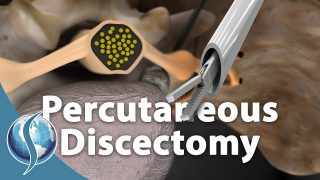Herniated Nucleus Pulposus
The intervertebral disc has the function of a ligament, a shock absorber and a spacer. It is the structure that most connects two adjacent vertebral bodies with each other. Unfortunately, it can also be the origin of extreme sciatica episodes when the inner part of the disc becomes a Herniated Nucleus Pulposus.
Like many other physicians, I like to use the example of the jelly donut when describing an intervertebral disc.
The outer part, or the “bread” is a very firm ligament structure called the Annulus Fibrosus (AF). It is like a woven braided wall that helps contain the inner component of the disc call the Nucleus Pulposus (NP).
The nucleus pulposus is a soft jelly like material that pressurizes the disc, allowing it to have the shock absorption, and ligament function. Early on in life, the disc has a type of proteoglycan (protein) that draws and holds water. As we age, the proteoglycan changes, so it has less water holding properties. The lack of water in the disc leads to less water pressure on the disc wall or annulus fibrosus, and will lead to a bulging of the side walls. I often use another analogy of a car tire. When the air leaks out, the side walls bulge out. That analogy is similar to the lack of water content causing the discs to bulge as we age.
Sometimes, the disc wall, or annulus breaks or fissures, allowing the soft disc material to rupture out, and cause pain by pressing on the nerves. Chemicals in the disc also can cause inflammation to tissues it contacts, and therefore, some will say the disc rupture will also cause a “chemical neuritis” or chemical inflammation of the nearby nerves.
For the past few years, some researchers have identified a break of the end of the vertebral body, or the endplate, that causes the annulus to give way, and cause the disc to herniate and cause pain.
HNP’s, and disc bulges are an expected finding, and will effect more than 50% of the population by middle age.
While herniated discs can be a very painful experience, the vast majority of them become asymptomatic within 3 months.
Spine Surgeons get involved when the effects of the herniated discs do not go away with standard treatments, or cause significant neurologic problems such as progressive weakness, and inability to control bladder and/or bowel functions. As always, the individual circumstance must be weighed and the risks and benefits of surgical management must be discussed. Fortunately, emergency surgery remains rare. If you have significant pain, are losing muscle control, and cannot control your bowel and bladder, stop reading this Blog and call your doctor, or go to the ER. For all others, make an appointment to get an evaluation about your options if you think you have a herniated disc that is not getting better.
Last modified: June 19, 2019









